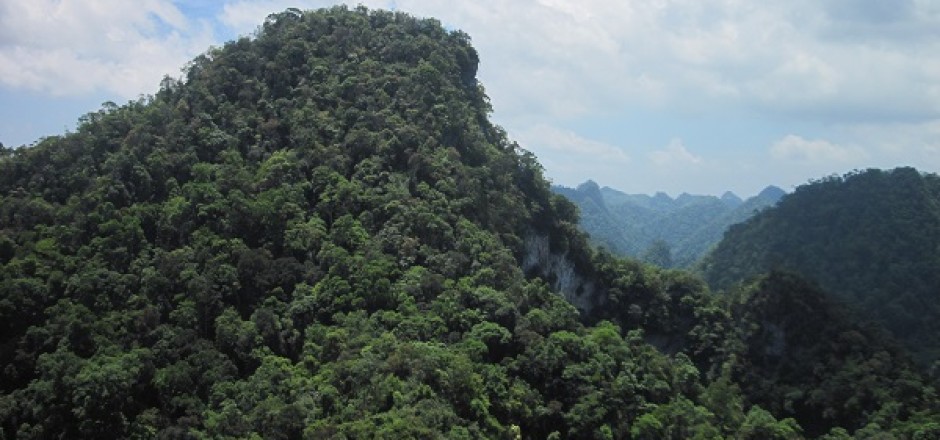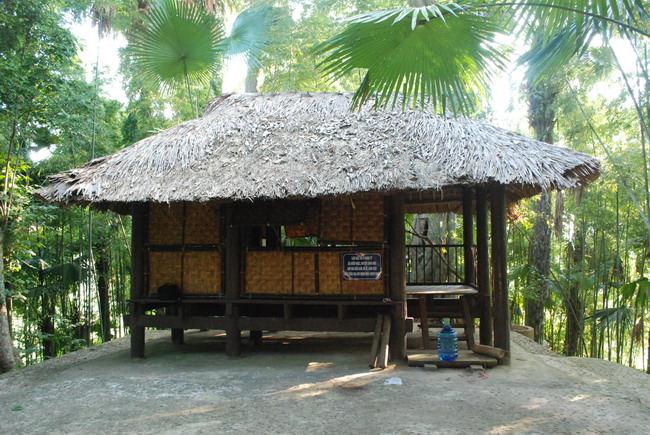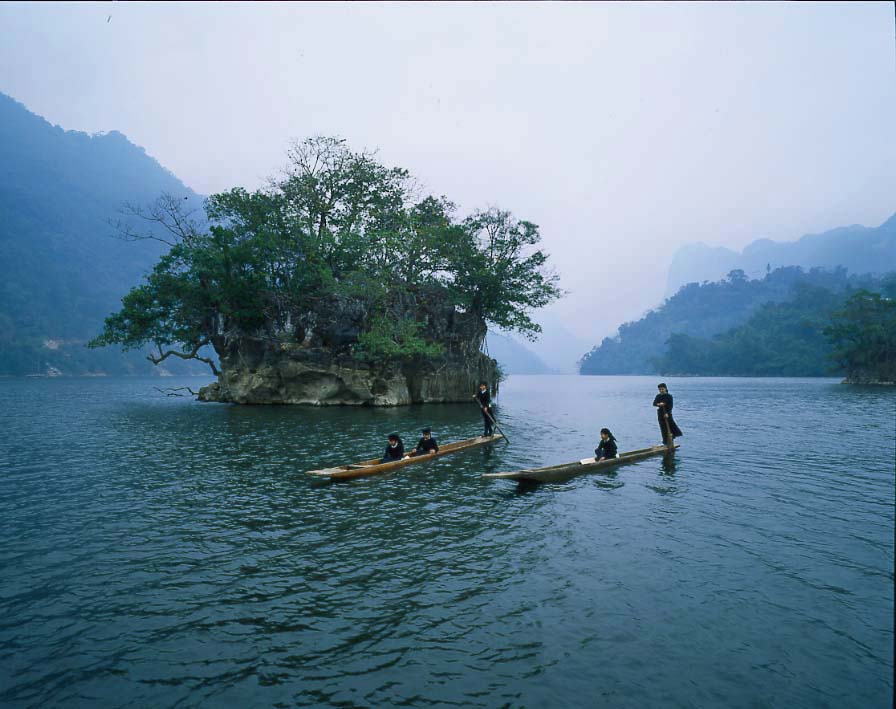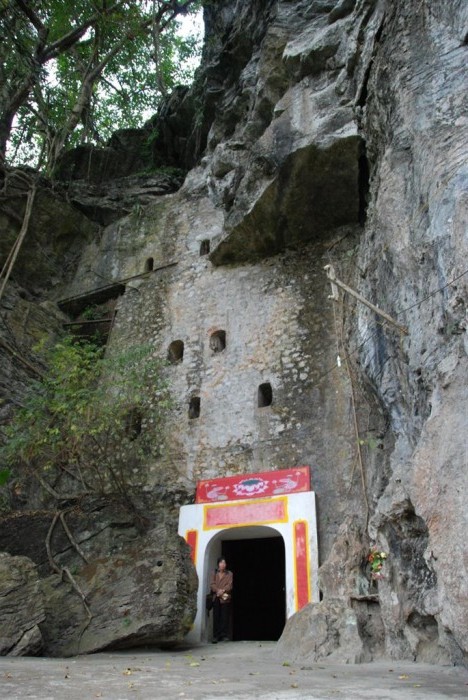|
The top destinations in Bac Kan
Located in the northeastern
part of Vietnam, about 170 km away from Hanoi, Bac Kan is a province rich in
tourism potential. This feature is credited to Bac Kan's abundance in natural
resources (including land, forest and mineral resources) as well as its charm
in cultural identity (with 7 ethnic minority groups).
Located within the precinct of Ba Be National Park, Ba
Be Lake is the largest natural freshwater lake in Vietnam and is among the
world's 20 most beautiful water lakes. The lake's water is of crystal clear
aqua, looking like a precious emerald, and is outstanding among the majestic
mountains of upper North Vietnam. Visiting Ba Be, you cannot omit enjoying a
boat ride on the lake's surface, bathing at Ba Goa Island, or gazing in admiration
at the karst features of Puong cavern.
In addition, tourists can pay several visits to a wide
range of caves and caverns in Bac Kan: Na Poong, Ba Cua (Three Gates), Son
Duong (Chamois), Nang Tien (Fairy).
Those who are interested in history can drop by Na Tu
relic at Cam Giang commune, Bach Thong district where Uncle Ho's poem of
encouraging Vietnamese youngsters was read for the first time. Its underlying
message is of much importance even today: As long as we stand our ground,
nothing can trouble us.
In such spirit, visit ATK Cho Don to experience a
little bit of the atmosphere during France-Vietnam wartime. The landscape
around this revolutionary base is indeed poetic, with houses hidden in trees
rows, wavy slopes, as well as cool and fresh streams.
In terms of specialties, people living in Bac Kan have
an endless number to proud of. It could be dzong vermicelli - miến dong, a
type of arrowroot noodles, bee sweet soup - chè con ong, which is made from
sticky rice, ginger root, sesame, molasses and honey, or Bo Nam wine - a kind
of sweet wine fermented from corn and herbs.
It could also be any kind of agricultural product grown
here: Quang Thuan tangerine - a special type of tangerine from Quang Thuan
commune which is unbelievably delicious, Bao Thai rice, field mushroom,
ginger, taro, potato, and so on. Hopefully, the province can spread their
delicacies widely.
Belows are the top destinations in Bac Kan province:
Pac Ngoi Village

Pac Ngoi Village has more than 40 traditional stilt
houses locating on the slope of mountains which surround Ba Be Lake,
emphasizing the beauty of this famous ecotourism destination.
Surprisingly, while the traditional stilt houses have
almost been eradicated in many other provinces, the antique, unique and
original houses of ethnic groups are still highly valued and preserved in Pac
Ngoi despite the presence of modern architecture.
According to the local government, it is not the lack
of money that keeps the inhabitants from building new and convenient houses
but the love for their ethnic heritage. They strive to preserve and protect
those cultural values from disappearing forever, because without these
beautiful stilt houses, Pac Ngoi Village is no longer Pac Ngoi village.
Visitors coming to Pac Ngoi are not only entitled to
witness the most wonderful scenery of Northern Vietnam - plethora of austere
yet interesting stilt houses blending themselves with the glimmering mist and
the shining Ba Be Lakes - but also to stay in the rhythm of the Tay culture.
This claim can be easily proven by the fact that
visitors have to remove their shoes once they step on the staircase of a
stilt house. Inside the house, ethnic people gather around the gleaming
fireplace, forgetting themselves in the sophisticate stories about the economy
or politics.
They create a world that shares nothing in common with
the big cities where electric lights and high buildings are ubiquitous. They
are there, in their beautiful social center, waiting to share their most
interesting stories about life with you.
Overnight in a homestay in the village will help you
save costs and understand the customs and lifestyle of the Tay ethnic group
in Vietnam.
Kim Hy Nature Reserve

Kim Hy Nature Reserve is located in Bach Thong and Na
Ri districts. It is a reserve of primeval nature with hundreds of rare flora
and fauna species. Among them, Presbytis francoisi francoisi, squirrels, and
monkeys are endangered species all over the world.
You will see diversity of bat species, reputed to be
the most in Vietnam. In addition, the natural reserve is a large valuable
wood-store in Bac Kan Province with hundreds of thousands of nghien, lat,
dinh trees, mountain pine, etc.
Kim Hy is also home to endangered flora species such as
stone-pine (thiet san gia) which is only present infour mountainous provinces
of North Vietnam and two provinces of Guangdong, Guangxi (China). Besides
diverse fauna and flora, the Kim Hy Natural Reserve is abundant in minerals,
especially gold.
ATK Bac Kan

"An Toan Khu - ATK", meaning "safe
zone". Constructed during the revolution against the French, ATK is a
complex of underground tunnels and rooms emboldened by a missile defense
system in Cho Don (Bac Kan).
This invincible complex was one of the most important
venues of the Vietnam Army from 1946 to 1954, where President Ho Chi Minh and
many other leaders gathered, discussed and made vital decisions involving the
destiny of the nation.
In the long and unending war against French
colonization, Cho Don was chosen to be the Safe Zone of the revolution. Since
then, this land had welcomed and protected many Central Departments, as well
as the most influential leaders of the Communist Party of Vietnam.
In the time between 1947 and 1952, almost all of the
Central Departments had their headquarters in Cho Don. As a result, the
underground tunnels were built in order to protect the prominent leaders and
officers.
Deep down underground, a complicated system of paths,
tunnels, and rooms were created. The construction was covered with a defense
system that is able to withstand bombs and bullets of the enemy.
Coming to ATK in particular and Cho Don in general,
tourists can not only visit many historical sites but also learn more about
the lives of the local inhabitants, discovering their most beautiful cultural
aspects which can only be found there.
Ao Tien (Fairy) Pond
.jpg)
Ao Tien is a small pond with a total width of about 3
hectares. The pond is located at the middle of Limestone Mountain andis
surrounded by trees. Water of the pond is always clear.
Sitting on the bank of the pond, tourists can see fish
and shrimp. On brushwood, monkeys live. The pond is also surrounded by
primary forests.
On rainy days, water in the pond is brown and muddy,
leading to a change in the water of Ba Be Lake. Ao Tien impresses tourists
with its unique secret beauty. The climate is cool and temperate.
Puong Cave

Puong Cave located on the Nang River, 5km from the town
of Ba Be District, Bac Kan province, was created by the river current as it
flowed next to the base of the Lung Nham Mountain, which is a chain of
limestone mountains.
Looking into the cave, 30m high, 300m long, you will
see that it is inhabited by thousands of bats belonging to 18 species.
After exploring the cave, you will note that Nang River
flows at the foot of the limestone mountain, goes through Puong Cave to reach
Ba Be Lake, and consists of a series of spectacular cascades between
perpendicular walls of rock.
Ba Be Lake

Located in the middle of a vast limestone mountain
range of Ba Be District, Ba Be Lake is dubbed a "precious jade of
Vietnam" and one of 500 lakes recognized as worthy of attention.
The origin of its name can be traced back to legends,
in which Ba Be was formed by three vast lakes: Pe Lam, Pe Lu, Pe Leng,
creating Ba Be's immensity. As you can see, "Ba" means
"three", and "Be" is a Tay word which means
"lake". The water from these three lakes can traffic through one
another; however, people cannot use boats to travel among them because of
rocks. In the middle of Ba Be is a small mound named Widow's Island (Go Ba
Goa).
The climate is cool with an average temperature of
22ºC. The best time to visit the area is during the dry season, which is
during winter and spring. The area was established as a national forest
preserve and tourist center in 1978.
Ba Be Lakes area has a lot to offer, including waterfalls,
rivers, valleys, lakes, and caves all set amidst picturesque landscapes. It
is surrounded by many ancient trees, from which several varieties of precious
wood are obtained. Up to 30 animal species such as wild pigs, bears,
panthers, monkeys, and birds inhabit the area.
Ba Be Lakes, located 145m above sea level, are among
the largest natural lakes in Vietnam with a total surface area of 500ha. The
surface of the lake is tranquil, a beauty spot, in this land of beauty.
Visitors will have an unforgettable stay in the mountains by the lakes,
enjoying sightseeing boat trips, hikes, and water sports.
From Ba Be, tourists can visit other neighboring scenic
attractions such as Dau Dang Fall, Puong Cave, and Tien Pond. Passing by
Puong Cave (30m high, 300m long), cruise past the villages of Tau, Cam and
Hua Tang, and navigate the way through the river's forks and brooks, to reach
Dau Dang Falls.
The falls laps over 1,000m on three levels, each
bursting with energy from the mountains that help fuel them.
Ba Be National Park

Ba Be National Park is an ideal eco-tourism site with
beautiful landscape and diverse biology, Ba Be National was recognised as an
ASEAN Natural Heritage Site in 2004.
Ba Be National Park covers an area of 7,610ha and has
3,000 inhabitants of the Tay, Mong, Dao living there. The national park
boasts primeval forest on old limestone range that surrounds pure
lakes.
The park consists of 1,281 species of plants including
162 families, among which 25 species have been recorded in the Red List of
The International Union for the Conservation of Nature and Natural
Resources-IUCN.
The fauna of national park is also multiform with 81
species of animals, 27 species of reptiles, 17 species of amphibians,
322 species of birds, 106 species of fishes, 553 species of insects and
spiders, of which 66 species have been listed in Vietnam and World Red Book
such as Great hornbill, Rhinopithecus avunculus, Presbytis francoisi
francoisi ...
Ba Be Lake is a hoghlight of the national park with its
outstanding landscape and geological features. The 500ha-lake is one of 20
largest natural freshwater lakes worldwide.
The lake is also home to some 106 species of freshwater
fish, of which there are valuable and rare species as Ba Be paramesotriton
deloustali, Bagarius yarrelli sykes ... In addition to Ba Be Lake, the
national park boasts unique and imposing tourist spots namely Puong Grotto, Dau
Dang Waterfall, Tien Pond.
Thach Long Pagoda

Thach Long Pagoda (or Stone Dragon) is located inside a
large stone grotto of Thach Long Mountain lying parallel with High Way 3.
Driving from Bac Kan city to Thai Nguyen for 19-20 kilometers, tourists in
Vietnam travel will see the gate of Thach Long Pagoda on the right.
No one knows when the pagoda began worshipping Buddha,
Saint and the Holy Mother. Elders say that a long time ago the people of Vi
Huong commune took statues to their pagoda called Hoa Son, where they found a
beautiful natural grotto inside Thach Long Mountain. They immediately took
the statutes to the grotto and worshipped them there.
Yet not until the 19th century was Thach Long Pagoda
officially worshipped by the people.
In the war against French colonialism, the pagoda
became a weapon producing place and storage and the people stopped
worshipping there.
In 1949-1950, President Ho Chi Minh visited the pagoda
three times and in 1950 stayed here for one night.
In 1954, the pagoda became the Bac Thai Weapon
Transport Station. Peace was re-established, the pagoda was given back to the
locality and native people re-established the pagoda.
Tham Temple

Tham Temple is 600 meters northwest of Cho Moi town.
The temple bases on the foot of Quan Thung Mountain. The temple worships a
woman general named Tham, who tremendously contributed to the war against Co
Den enemy in the second half of the 19th century.
The temple complex consists of main temple, Co Tham (Ms
Tham) shrine and Son Than (mountain god) shrine. The temple has three rooms.
Previously, the temple worshipped Son Than and Thuy Than (water-nymph). The
temple was not repaired until the second half of the 19th century.
It is said that in the old days there was a beautiful
girl who is a daughter of a poor fisherman. Her name was Tham. All young men
in the region loved and wanted to get married with her. Unfortunately, a
wicked feudal lord used his power to force her to become his wife. The lord
was a henchman of the enemy.
Ms Tham managed to get out of his house and called on a
team of poor people to struggle against the enemy. Upon knowing that Ms Tham
became a woman general, the feudal lord took enemy troops to fight her. A
bloody battle occurred at the junction of Trang Co River. Ms Tham bravely
directed her troop.
Unfortunately, Ms Tham died from a poisonous arrow. To
commemorate a brave woman general, natives built a temple on the floor of her
house to worship her. Since then, the temple has been called Tham.
In the early days of spring, Tham Temple holds a
festival on the sixth of January lunar calendar and closes on the sixth
of April. The festival attracts a large number of visitors.
Nang Tien (Fairy) Grotto

Fairy Grotto is a beautiful natural spot locating at
the Phja Trang mountain range in Luong Ha commune, Na Ri district, Bac Kan
Province.
The grotto is 5 km from Yen Lac town. Legend says that
once upon a time there were 7 fairies landing at the foot of Phja Trang
Mountain to swim. They enjoyed themselves so much that they did not know when
night came. They could no longer fly back to heaven. God created a grotto for
them to reside.
Since then, the grotto has been called "Fairy
Grotto". On 13 September 1999, the Ministry of Culture and Information
signed a decision recognizing the Grotto as a beauty spot at the national
level.
Compiled by Pha
Le, VNN
|
Thứ Ba, 18 tháng 10, 2016
Đăng ký:
Đăng Nhận xét (Atom)
Không có nhận xét nào:
Đăng nhận xét